Idiyappam Recipe | Nool Puttu (String Hoppers)
Idiyappam, also known as Nool Puttu is a specialty from South Indian cuisine and are basically string hoppers or seviyan/sevai. This is one of the widely popular Breakfast Recipes in South India. This Idiyappam Recipe is going to make it easy for you to try this lovely dish at home. Although, it is made with a simple rice flour dough, but you need to know the nitty gritty and the correct way of making it. Or else, you won’t get the desired soft and smooth Idiyappams. With minimal ingredients, the recipe is naturally vegan, gluten-free and a healthy one too.
All About Idiyappam
Like I said in the beginning, Idiyappam are actually string hoppers or a rice noodle/vermicelli dish with its origin in South India.
The term “Idiyappam” comes from Tamil and Malayalam, where “Idi” means broken or pressed and “Appam” refers to traditional rice-based dishes like the the classic Appam (Palappam), Sweet Appam, and Unniyappam, and many more varieties that can be steamed, fried, or pan-cooked.
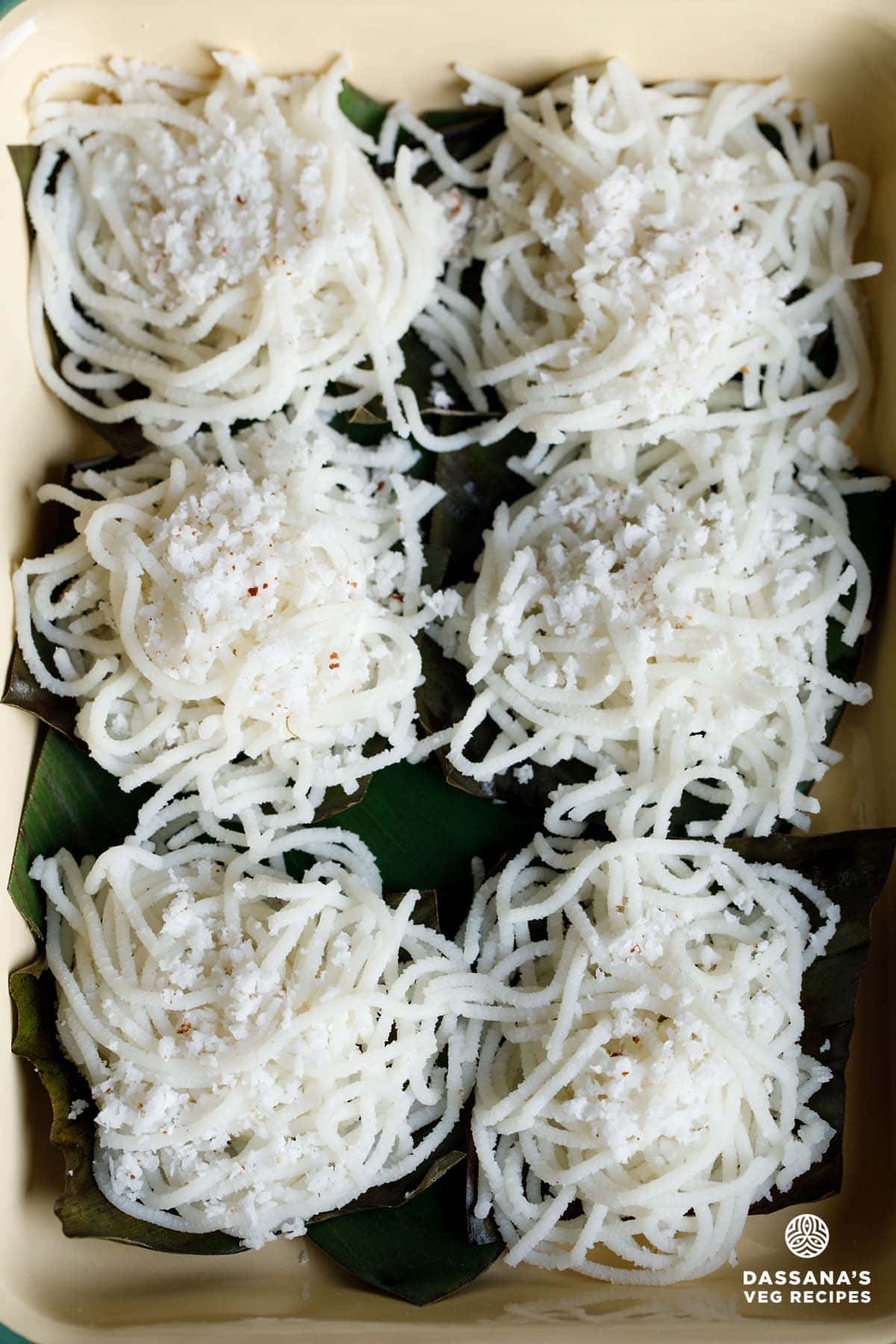
But just like many other dishes, the Idiyappam recipe is common under different monikers in different regions of South India.
The dish is traditionally called an Idiyappam in Malayalam and Tamil languages. Apart from this, it is the Nool Puttu in Kerala and Ottu Shavige in Karnataka.
Not just in India, these rice dough noodles are famous in other Southeast Asian countries. For instance, indiappa in Sri Lanka, putu mayang in Indonesia, putu mayam in Singapore and Malaysia, etc.
Table of Contents
Soft and light, these string hoppers are typically served with coconut-based curries or spicy stews, making them a versatile and wholesome meal enjoyed across the region.
During my growing up years, the Idiyappam Recipe was always a common breakfast dish at my home and my mother usually used to serve it with an earthy coconut chutney.
Till date, I love having it with the nicely made coconut chutney, which is actually not an authentic combination.
I do make these rice flour hoppers once in a while for breakfast. In addition to the water, the Idiyappam Recipe uses just 3 more ingredients in its making. These are rice flour, salt and the grated fresh coconut.
About My Recipe
Along with Puttu and Appam, Idiyappam is a much-loved breakfast in Kerala and some other South Indian states. It tastes best with a good curry, kurma or otherwise even with a coconut chutney or any side dish of your choice.
The Idiyappam recipe is an easy one, provided you follow it well. To get soft Idiyappams, there’s a certain way that you have to go about in prepping up the dough. If you stick to the recipe and the procedure, you will surely achieve the desired results.
I have mentioned all the key points that are essential in making cushiony soft Idiyappam, in the step-by-step demonstration. Make sure you follow it precisely.
You can serve it with veg kurma, mushroom korma, Kadala Kari or Veg Stew. Even an Avial would taste fantastic with these hoppers.
For kids, you can even serve with slightly thinned Coconut Milk sweetened with jaggery. You can also sprinkle some sugar on top and serve them.
Alternatively, you could also use steamed Idiyappam to make Semiya Upma or Semiya Payasam.
Rice Flour Quality
Always use fresh, fine-textured rice flour (or premade roasted idiyappam flour) for best results. Old or coarse rice flour can make the the texture dense, hard, or break while pressing. If possible, sieve the flour before using to ensure a smooth, lump-free dough.
To check the quality of rice flour, ensure it has a fresh, neutral rice aroma without any sourness, feels fine and smooth to the touch (not gritty), and lightly holds together when pressed between your fingers.
As always, I would suggest to use homemade rice flour, but make sure it is finely ground. Do check my detailed post on How to Make Rice Flour at home.
How to make Idiyappam
1. Before you begin making the dough, grease oil on an Idli pan or a steamer pan and keep ready.
If you have banana leaves, then cut them in squares and place them on the idli moulds or idli plates. Grease the banana leaves with some oil.
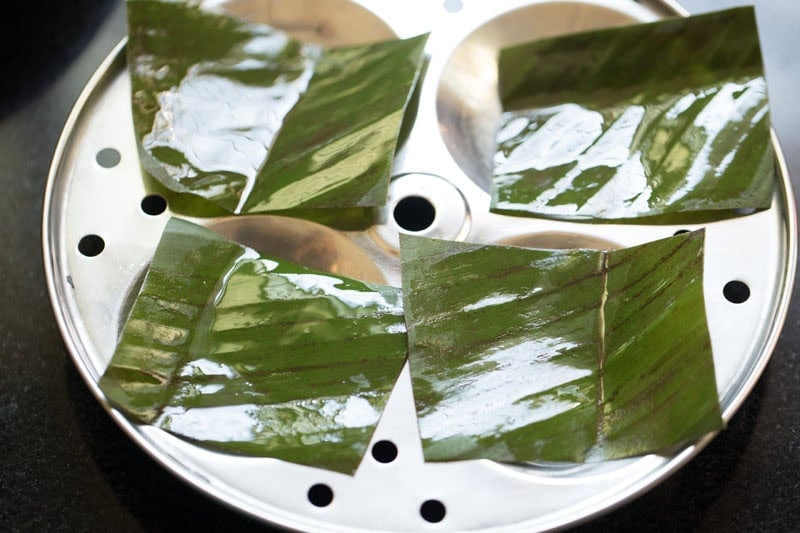
Roast Rice Flour
2. Heat a kadai or pan. Keep heat to low and add 1 cup (130 grams) rice flour.
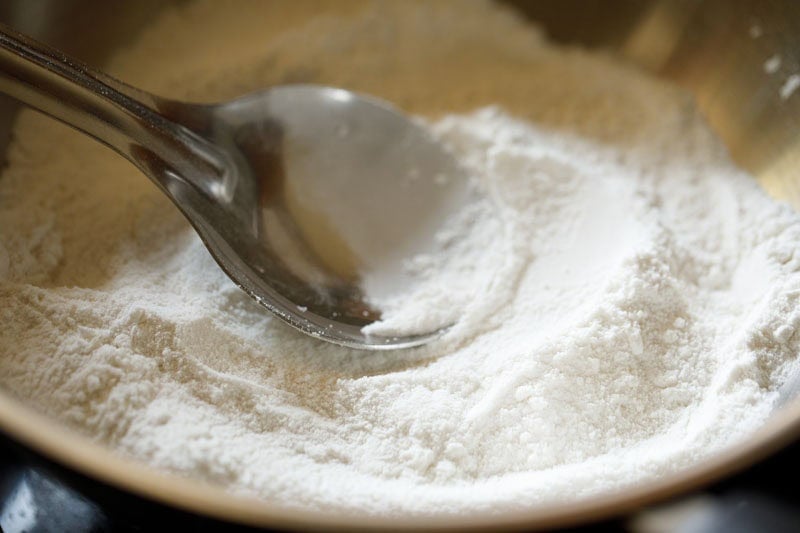
3. On low heat, stirring often, roast the rice flour for 4 to 5 minutes. You don’t need to brown the flour. It’s just lightly roasted and this helps in making soft Idiyappams.
Continue to stir and roast till you see steam coming from the rice flour.
When you see steam appearing from the rice flour, then switch off the heat. Remove the rice flour in a mixing bowl or pan.
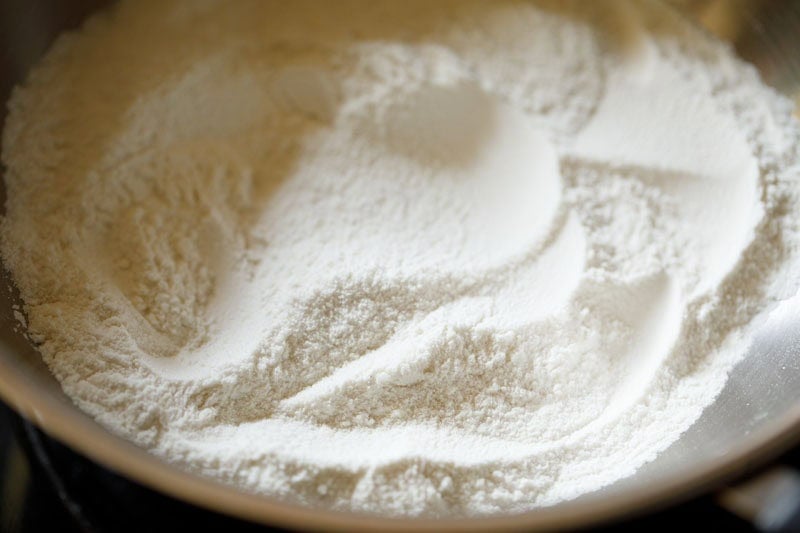
Make Dough
4. In the same kadai or pan in which rice flour was roasted, add 1.25 to 1.3 cups water and ¼ teaspoon salt.
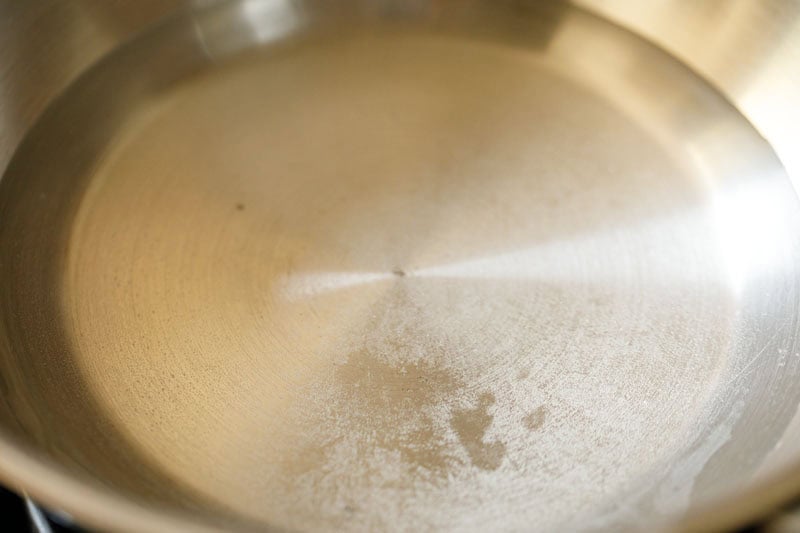
5. Let the water come to a boil. The water has to be hot but should not be very hot. Do not allow it to come to a rolling boil.
When you see tiny bubbles appearing in the water and it begins to start boiling, that’s the time you switch off the heat.
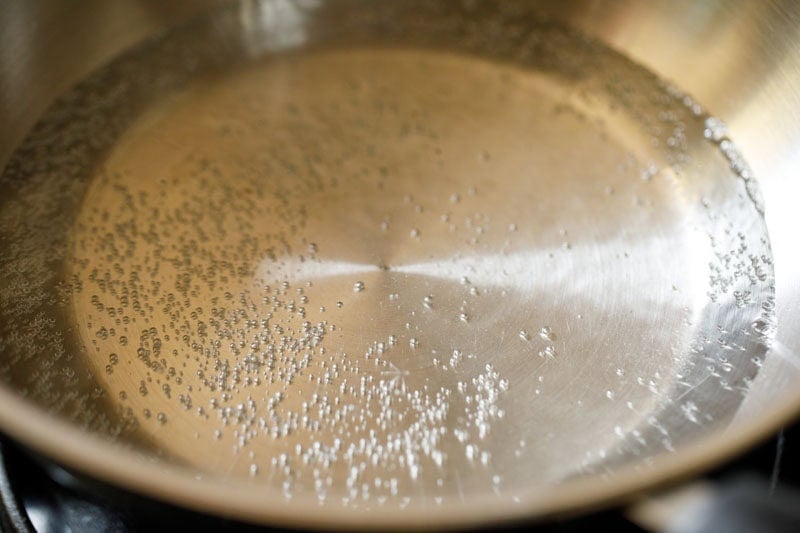
6. Add the hot water to the rice flour.
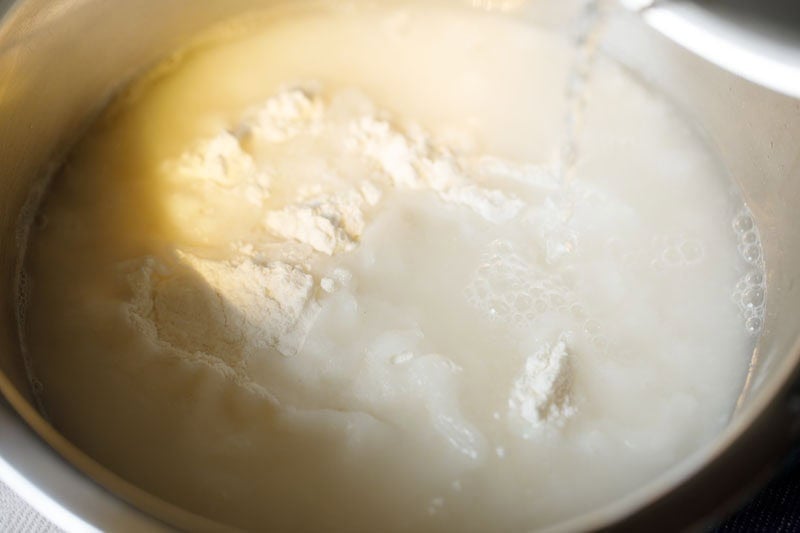
7. Begin to mix thoroughly with a spoon or spatula.
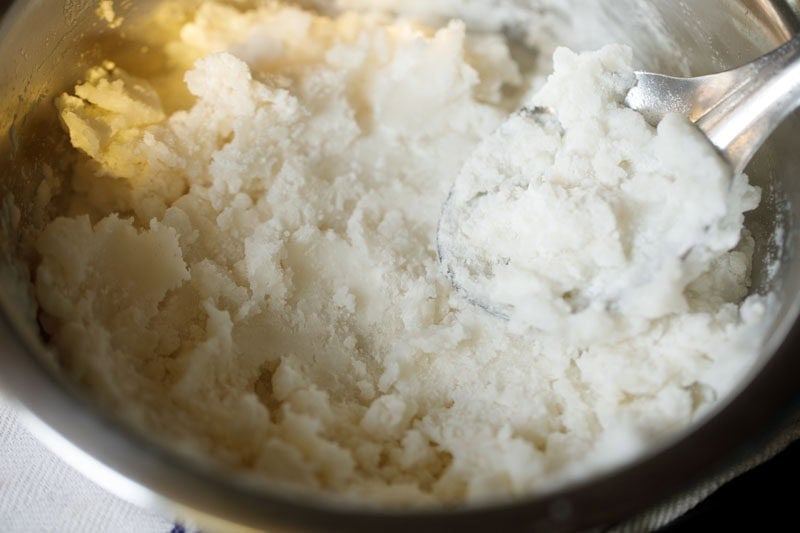
8. Keep on mixing and when the heat is tolerable, you can begin to knead. If you cannot knead, then wait for 1 to 2 minutes and when the heat is tolerable, then start kneading.
Note that the dough has to be hot when you knead.
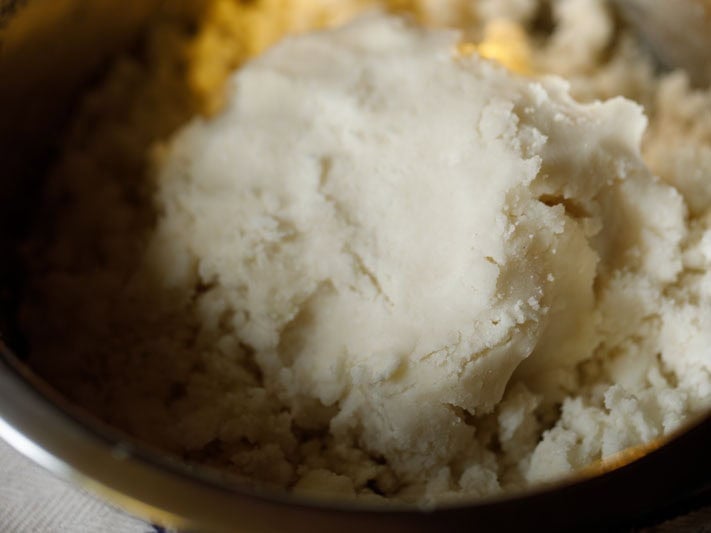
9. Knead to a smooth and soft dough.
Tip 1: If the dough looks dry, then you can sprinkle some warm water on it and continue to knead.
Tip 2: If the dough becomes sticky, then add a few tablespoons rice flour and knead.

Make Idiyappam
10. Take the disc meant for making Idiyappam and spread some water or oil on it.
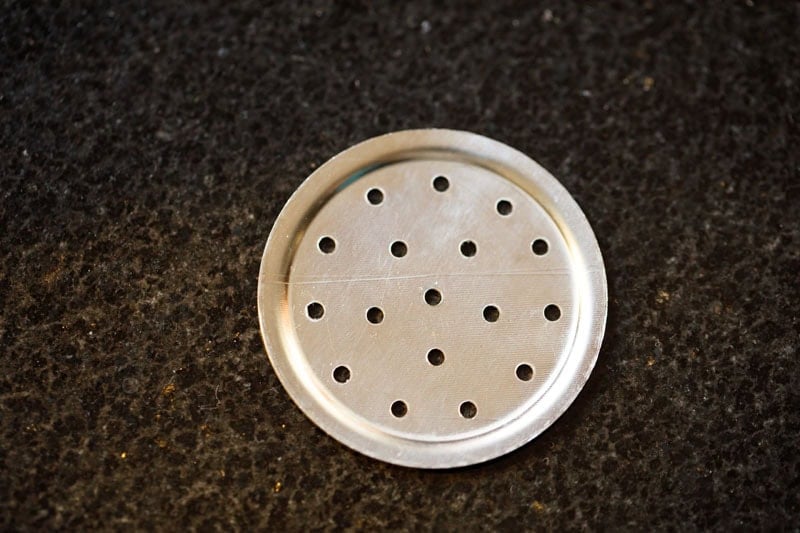
11. Before you start making Idiyappam, heat 2 cups water in a pan or pressure cooker and let it come to a boil. Keep water on medium-low to medium heat.
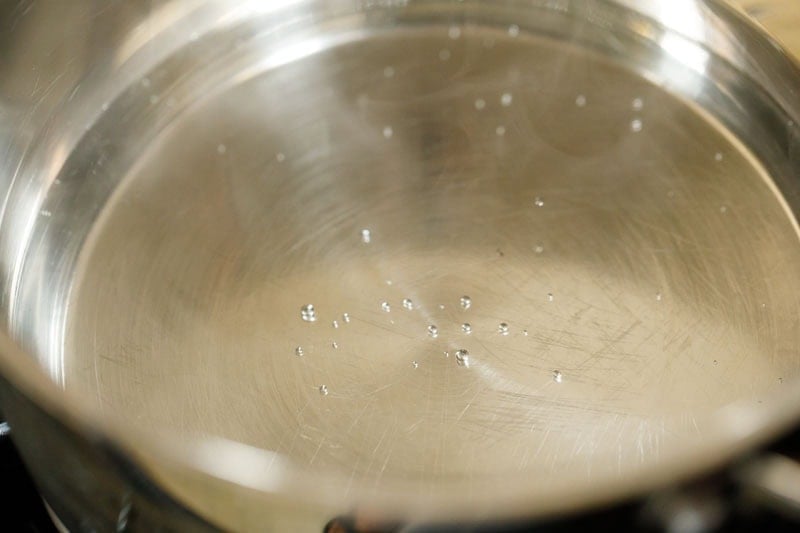
12. Divide the dough in 2 to 3 portions. Prepare a log from one portion and place it in the Idiyappam/murukku maker.
Tip: Grease the Idiyappam maker with some oil or water before you place the dough in it.
Note: Cover the rest of the dough with a kitchen napkin so that it doesn’t dry out.
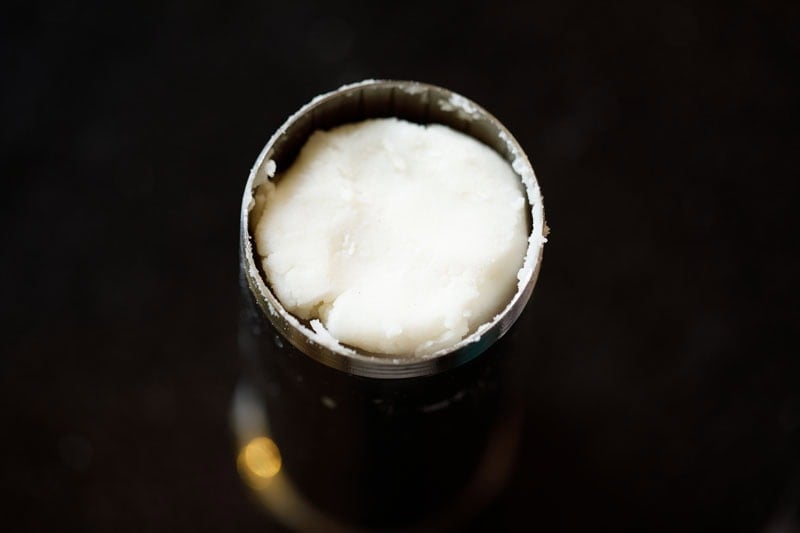
13. Now begin to press the dough in the Idiyappam/murukku maker directly on the idli moulds in a concentric circle.
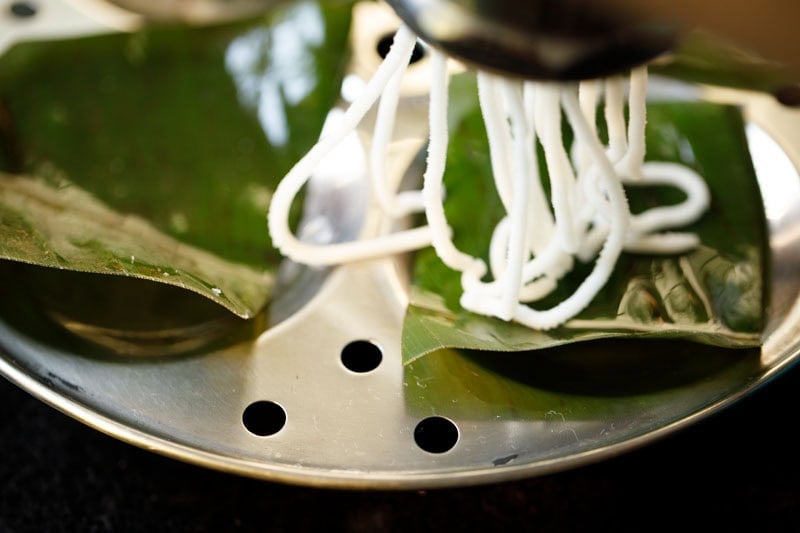
14. Form one roundel of the Idiyappam.
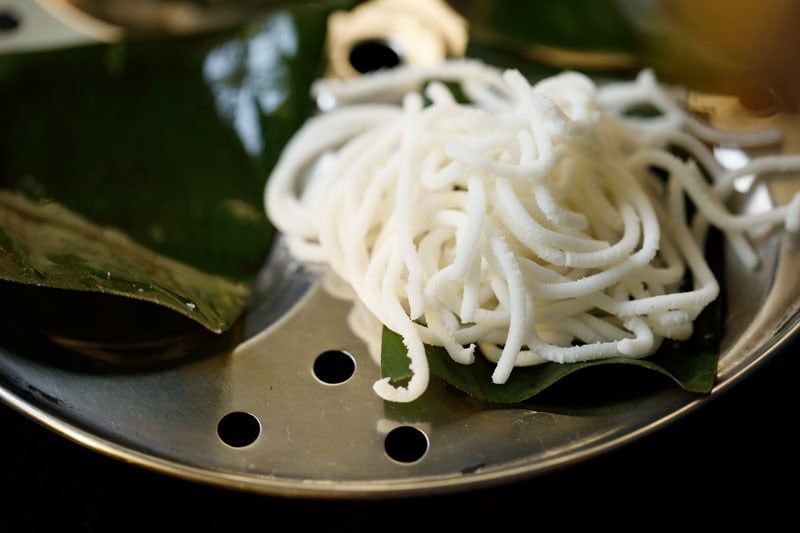
15. While making the rest, the dough has to be hot or warm.

16. Continue to make the rest on all the idli moulds. Sprinkle some grated coconut on top of each Idiyappam.
Coconut is optional and can be skipped. Alternatively, you can sprinkle fresh grated coconut and sugar just before serving.
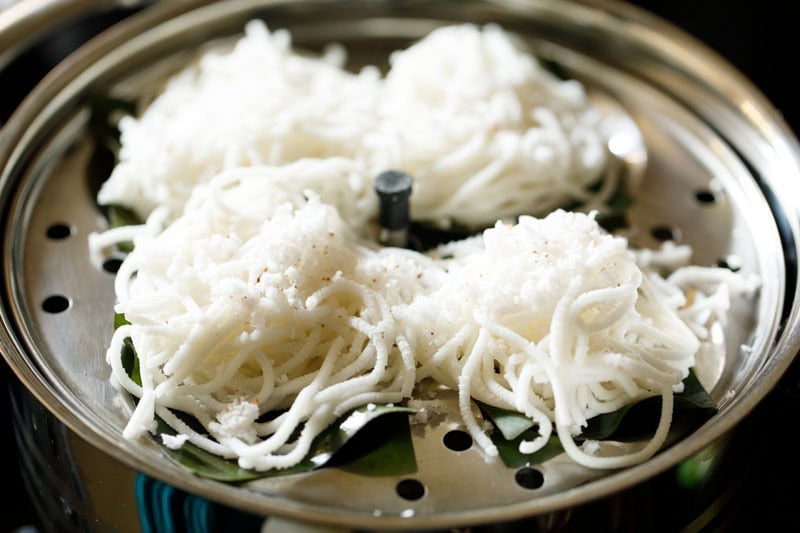
17. Now, place the idli stand in the pan. Cover pan with a lid.
Note: If using pressure cooker, then remove the whistle (vent weight), cover and seal the cooker.
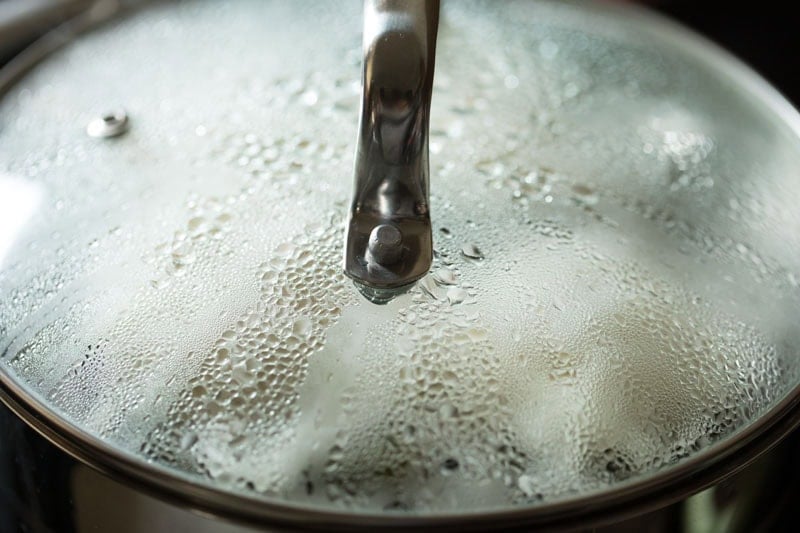
18. On medium to high heat, steam Idiyappams for 9 to 10 minutes. After they are cooked well, switch off the heat and let them be inside the steamer pan for 1 to 2 minutes.
Then, carefully remove the stand from the pan. Remove the Idiyappam with a spatula and serve.
If you have used banana leaves, then you just need to pick up the banana leaves and serve. If not serving immediately, then place them in a casserole, so that they stay warm.
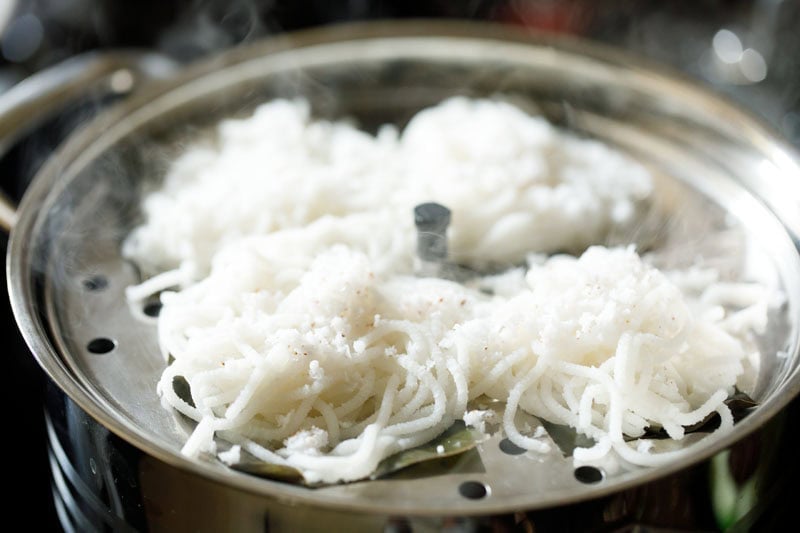
19. Serve Idiyappam hot or warm or at room temperature.
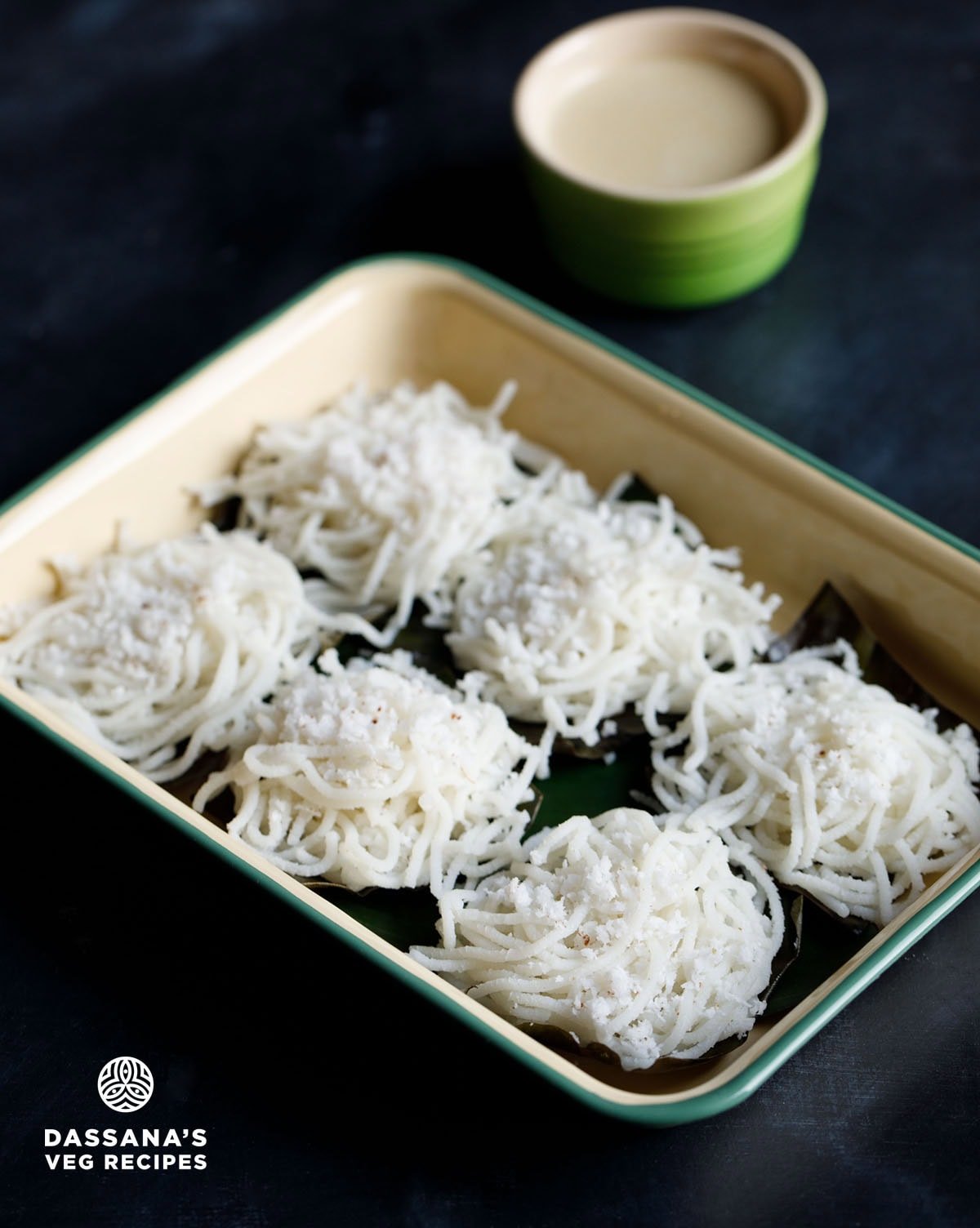
Serving Suggestions
Idiyappam tastes best when served hot with Vegetable Kurma, Potato Kurma, Mushroom Kurma, or Kerala-style Potato Stew. You can also pair it with jaggery-sweetened coconut milk for a mild, sweet pairing.
You can enjoy it with South Indian side dishes like kadala curry, tomato kurma, Coconut Chutney, or even a simple vegan or vegetarian stew for a wholesome meal.
Storage Suggestions
Idiyappam stays fresh a few hours at room temperature if kept covered. For longer storage, refrigerate in an airtight container for up to 1 day.
To reheat, steam the idiyappam for 3 to 5 minutes until soft, or microwave by sprinkling a few drops of water. Avoid reheating directly on a pan as it can make the strands dry and hard.
Expert Tips
- Roasting Rice Flour: To make soft Idiyappams, make sure to lightly roast the rice flour, and not brown it. Keep stirring, while roasting the rice flour.
- Kneading: The rice flour mixture has to be hot when you knead. So, if you cannot knead, then wait for about 1 to 2 minutes. When the heat is tolerable, then begin kneading.
- Dough Texture: If the dough is dry, then sprinkle some warm water on it and continue to knead. If the dough is sticky, then add a few tablespoons rice flour and continue to knead.
- Coconut: Sprinkling of fresh grated coconut is optional. You can skip this step. Alternatively, you can sprinkle the coconut and some sugar too, while serving.
- Storing: If you are not serving the string hoppers immediately, then you can place them in a casserole. This way, they’ll stay warm.
- Millet Flours: You can opt to make idiyappam with millet flours like ragi flour as an alternative to rice flour. You can also use whole wheat flour to make string hoppers.
FAQs
What is idiyappam made of?
Idiyappam is made from a smooth and soft dough made with fine rice flour, water, and salt. The dough is shaped into thin noodles or vermicelli, using an idiyappam press and then steamed.
What is the difference between idiyappam and string hoppers?
There is no difference; both refer to the same dish. Idiyappam is the South Indian name, while string hoppers is a common English name used in Sri Lanka.
How to prevent idiyappam from breaking?
If the dough breaks while pressing, it means it’s too dry. Add a little hot water and knead again until soft and pliable.
Can I make string hoppers without an idiyappam maker?
An idiyappam maker or press is essential for shaping the noodles. Without it, you cannot achieve the thin, string-like texture.
Why is the texture of the vermicelli strands hard after steaming?
This hard or denser texture is a result of the dough being too dry or the strands being overcooked. Use enough hot water while kneading and steam for just 8–10 minutes.
Can I prepare nool puttu in advance?
Yes, you can steam them, cool completely, and refrigerate in an airtight container for up to a day. Re-steam for a few minutes before serving.
Popular South Indian Breakfasts To Try:
Step by Step Photo Guide Above
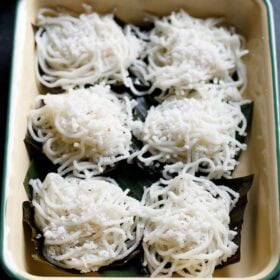
Idiyappam Recipe | Nool Puttu (String Hoppers)
Ingredients
- 1 cup (130 grams) Rice Flour
- 1.25 to 1.3 cups hot water – for kneading
- ¼ teaspoon salt or add as required
- ¼ cup coconut – freshly grated, optional
- 2 cups water – for steaming
Instructions
Preparation
- Before you begin making the dough, grease oil on an idli moulds or idli plates or a steamer pan and keep ready.
- If you have banana leaves then cut them in squares and place them on the idli moulds. Grease the banana leaves with some oil.
Roasting Rice Flour
- Heat a kadai or pan. Keep the heat to a low and add the rice flour.
- On a low heat stirring often roast the rice flour for 4 to 5 minutes. You don't need to brown the flour. It is just lightly roasted and this helps in making soft idiyappams.
- Continue to stir and roast till you see steam coming from the rice flour.
- When you see steam appearing from the rice flour, then turn off the heat. Remove the rice flour in a mixing bowl or pan.
Kneading Dough
- In the same kadai or pan in which rice flour was roasted, add water and salt.
- Let the water come to a boil. The water has to be hot but should not be very hot. Do not allow it to come to a rolling boil. When you see tiny bubbles appearing in the water and it begins to start boiling, that is the time you switch off the heat.
- Add the hot water to the rice flour.
- Begin to mix thoroughly with a spoon or spatula.
- Keep on mixing and when the heat is tolerable then you can begin to knead. If you cannot knead then wait for 1 to 2 minutes and when the heat can be tolerated then start kneading. Do note that the dough has to be hot when you knead.
- Knead to a smooth and soft dough. If the dough looks dry then you can sprinkle some warm water on it and continue to knead. If the dough become sticky then add a few tablespoons rice flour and knead.
Making Idiyappam
- Take the disc meant for making the idiyappam and spread some water or oil on it.
- Also before you start making idiyappam, heat 2 cups water in a pan or pressure cooker and let it come to a boil. Keep water on a medium-low to medium heat.
- Grease the idiyappam maker with some oil or water before you place the dough in it. Cover the rest of the dough with a kitchen napkin so that they don't dry out.
- Divide the dough into 2 to 3 portions. Prepare a log from one portion and place it in the idiyappam press/murukku maker.
- Now begin to press the idiyappam/murukku maker directly on the idli moulds in a concentric round circle.
- Form one roundel of the idiyappam. Note that while making idiyappams, the dough has to be hot or warm.
- Continue to make idiyappams on all the idli moulds.
- Sprinkle some grated coconut on top of each idiappam.
- Now place the idli stand in the pan.
- Cover pan with a lid. If using pressure cooker, then remove the whistle (vent weight) and cover and seal the cooker with its lid.
- On medium to high heat steam idiyappams for 9 to 10 minutes. After they are cooked well, turn off the heat and let the idiyappams be inside the steamer pan for 1 to 2 minutes.
- Then remove the idli stand from the pan. Remove the idiyappams with a spatula and serve the idiyappam.
- If you have used banana leaves then you just need to pick up the banana leaves and serve. If not serving immediately then place the idiyappam in a casserole so that they stay warm.
- Serve idiyappam or nool puttu with veg korma, potato korma, mushroom korma, veg stew or potato stew or jaggery sweetened coconut milk.
Notes
- Use fine, fresh rice flour or idiyappam flour for soft texture.
- Always add hot, boiling water while making the dough for proper binding.
- Knead the dough while warm until smooth and soft; cover with a damp cloth to prevent drying.
- Grease the idiyappam press and plates lightly with oil to avoid sticking.
- Press the dough while it is still warm; cold dough becomes hard and difficult to shape.
- Steam for 8–10 minutes only; over-steaming can make idiyappam dry and tough.
- If freezing or refrigerating, re-steam for 1–2 minutes before serving to restore softness.
- Coconut is optional and can be skipped. Alternatively you can sprinkle fresh grated coconut and sugar just before serving.
Nutrition
Idiyappam Recipe from the archives was originally published on November 2017.

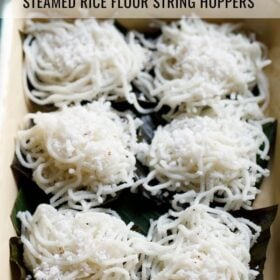
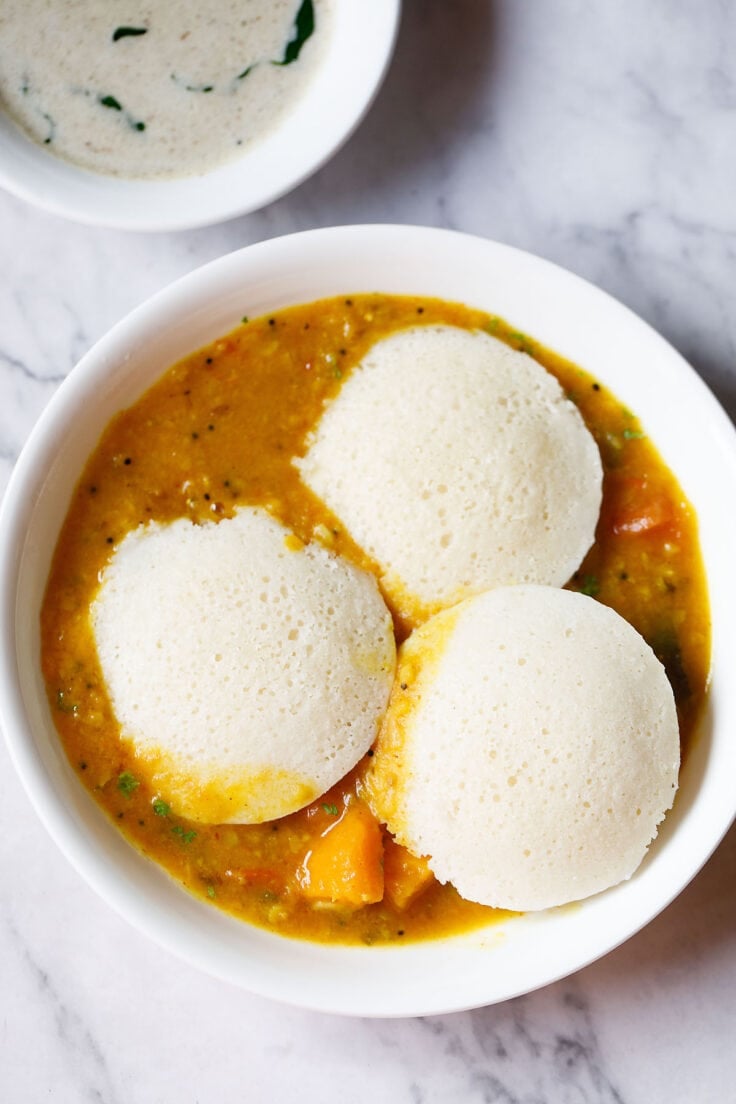
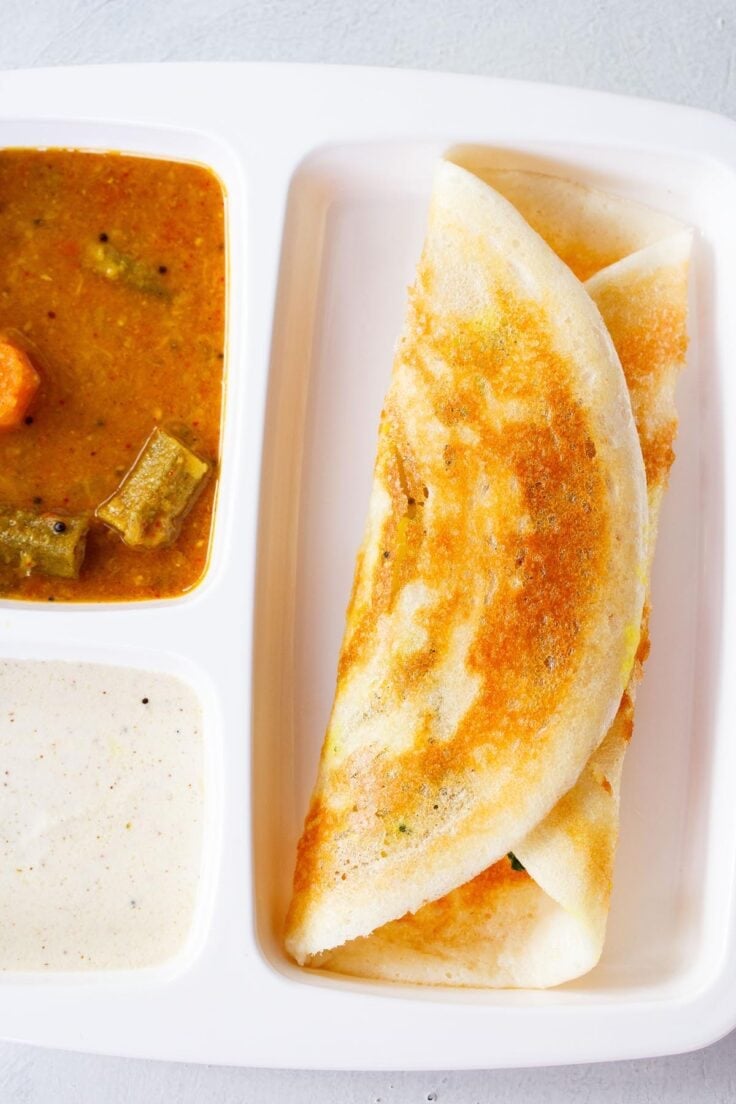
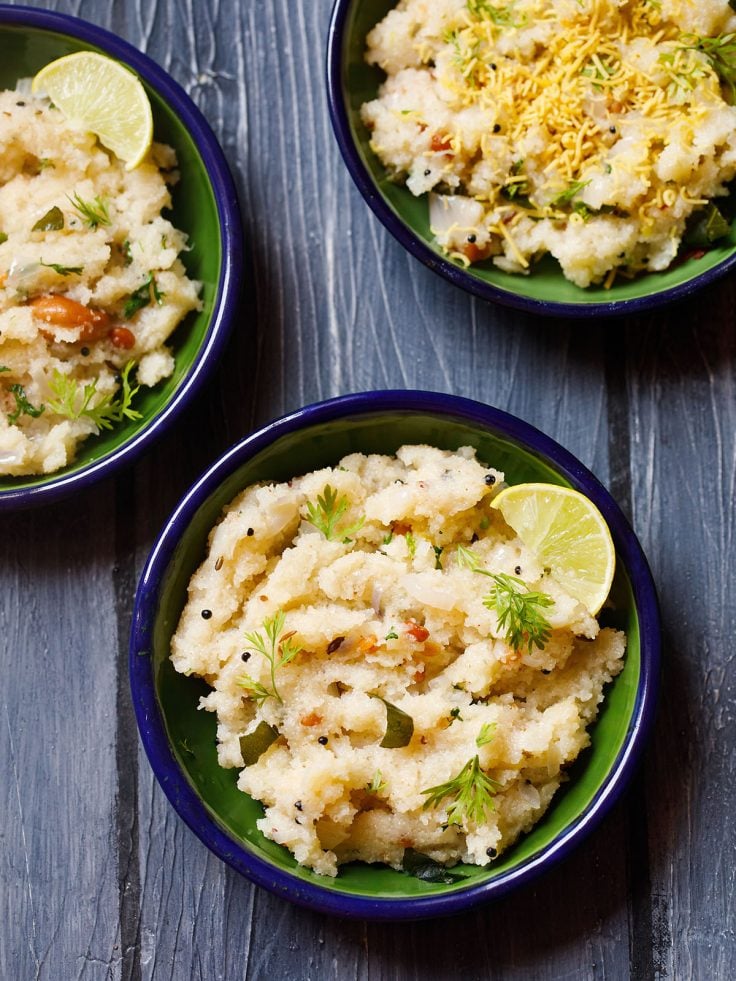
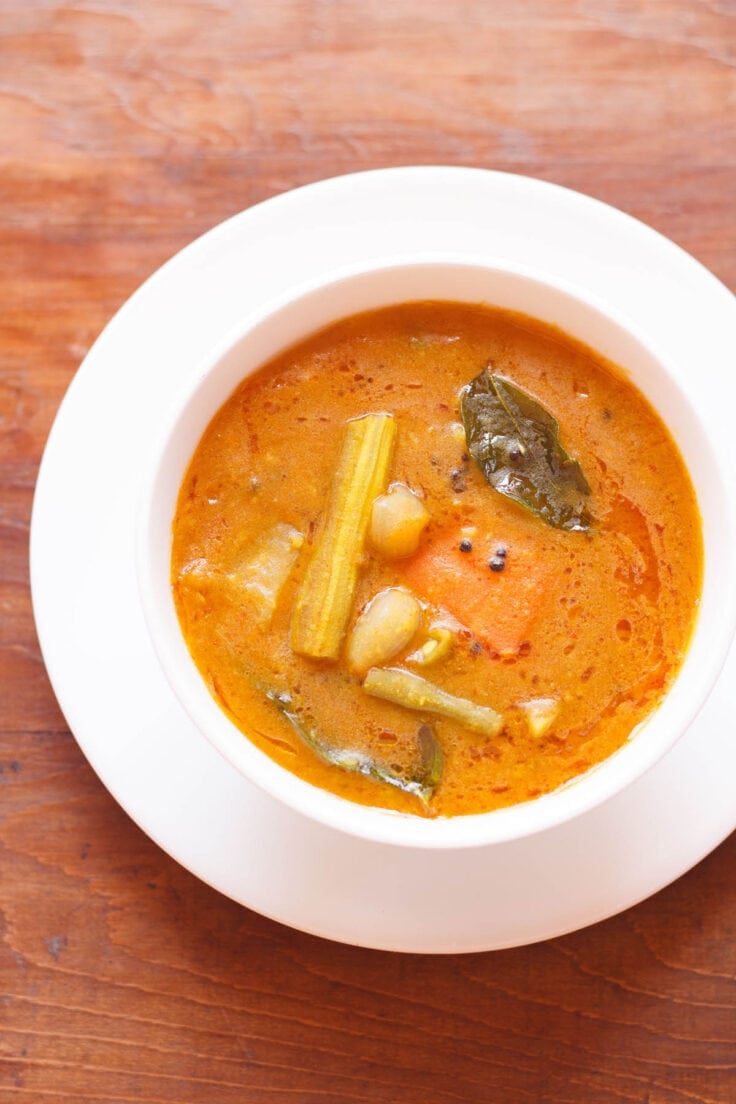
Thanks for the recipe. I had made flour out of red boiled rice. Can I make iddiappam from that flour?
Thank you. Yes, you can make Idiyappam with flour from boiled (parboiled) red rice, though the texture may be a bit denser compared to white rice flour.
Can I serve some North Indian curries with this?
Idiyappam is traditionally served with South Indian curries like vegetable stew, kurma, sodhi, or sweetened coconut milk. But yes, you can also pair it with mild North Indian dishes like aloo tamatar, matar paneer, or a thin moong dal. Just avoid heavy, creamy gravies as idiyappam is quite delicate.
Thank you for the recipe. Turned out awesome.
Glad to know and thanks for the lovely feedback on the recipe.
Amazing recipe. So well explained, beautiful pictures. You make cooking look so easy.
The idiyappam was soft and delicious!
Thanks a lot. I am glad that the photos and explanation are helpful to easily make the recipe. Good to know that the idiyappam was soft and tasty.
good one ..i tried it ..superb…thankyou for the details in making it…
thanks elizabeth.
Thank you for the step-by-step instructions. Tried this first time and turned out well. Thank You
Welcome Mythili. Glad to know this.